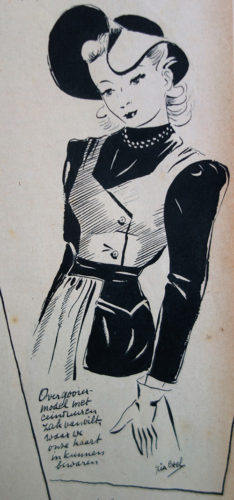In her article for COS about pockets, Rebecca Arnold discusses the exhibition ‘Are Clothes Modern?’ held in 1945 at the Museum of Modern Art, New York. According to Arnold, the exhibition’s curator Bernard Rudofsky signalled a degeneration of functionality in contemporary clothing and “bemoaned the excess of pockets in the tailoring of the time (24 by his calculation), many of which never carried anything”.[1] While spending the last few months doing research on the Dutch woman’s magazine Libelle, in particular its issues covering WWII, I was struck by the abundance of – often extravagantly large – pockets on both haute couture designs, discussed in the magazine’s regular fashion column ‘Libelle-Cocktail’, as well as on patterns for the home dressmaker. Praising their practicality, Libelle presented pockets as one of many “wartime phenomena” in fashion that may signal fashion’s response to immediate wartime conditions.
Unlike other Dutch women’s magazines, Libelle, a popular and still-existing ‘domestic weekly’ first issued in 1934, was continuously published for almost the entire duration of Germany’s occupation of the Netherlands (10 May 1940–5 May 1945). The magazine thus provides us with an interesting insight into Dutch domestic life under the pressing wartime conditions of food and textile scarcity. The Dutch textile rationing system, which was implemented on 12 August 1940 and was only abolished in November 1949, proved to be an ongoing, daily challenge for Dutch women responsible for keeping themselves, along with their families, adequately and, if possible, fashionably, dressed. Responding to the immediate needs of Dutch housewives, Libelle increasingly provided practical yet fashionable ideas on how to mend and make do with one’s wardrobe and make the most of one’s textile rationing card. Numerous sewing and knitting patterns were given, as well as instructions on how to make new garments, often from outworn or unused garments or from unusual materials. Practicality, frugality and diligence did not preclude modishness.
In its 19 April 1940 issue, Libelle mentions fashion’s “latest thing” from America, namely the ‘cash-and-carry-belt’. Resembling the ‘fanny pack’ (also: ‘bum bag’) popular during the late twentieth century, this belt with two large, attached pockets could be used to carry money and other small belongings. Libelle states that Parisian women wear this belt on their daily shopping trips, using one pocket for carrying money and the other for carrying the purchased goods. Providing a pattern and full description on how to make their own version of this wartime-related, American fashion novelty item, Libelle advises women to choose fabric “in accordance with the frock on which the belt will be worn”.

Pockets were a practical asset to any garment at a time when handbags were increasingly difficult to acquire due to scarcity of materials and rationing coupons. The cash-and-carry-belt, and similarly any type of large pockets integrated in or separately attached to a clothing item, could prove handy at times when citizens, frequently plagued by air raids, had to be prepared to quickly pack and easily carry their valuable belongings with them to bombing shelters.

As the complaint by Rudofsky suggests, the fashion for large pockets did not disappear with the cessation of war. In an article about her trip to London during spring 1946, Libelle correspondent Corry Erkens noticed that pockets, “a wartime souvenir”, were still en vogue, and were sported on coats, dresses, skirts and blouses.[2]

By Nelleke Honcoop
[1] Rebecca Arnold, ‘On Pockets’, COS website. Accessible via: https://www.cosstores.com/gb/Studio/Projects/On_Pockets (accessed: 16 September 2017). See also: Rebecca Arnold, ‘Are Clothes Modern? Or How to Read A Diagram’, Documenting Fashion blog. Accessible via: https://sites.courtauld.ac.uk/documentingfashion/2017/07/25/clothes-modern-read-diagram/ (accessed: 16 September 2017).
[2] Corry Erkens, ‘De Engelsche Vrouw en Wij’ [‘The Englishwoman and We’], Libelle, no. 6 (17 May 1946), pp. 20-23.


